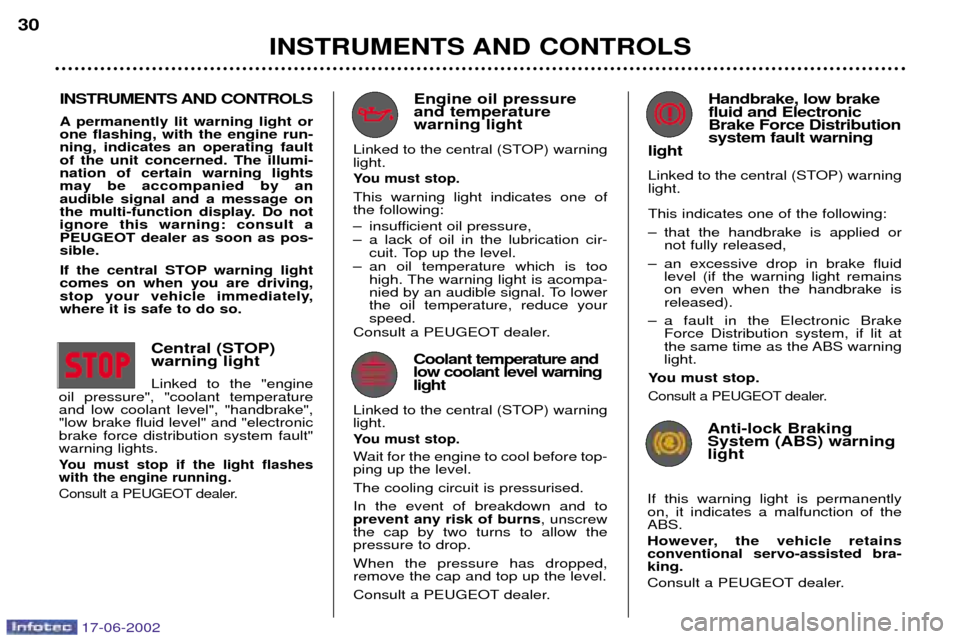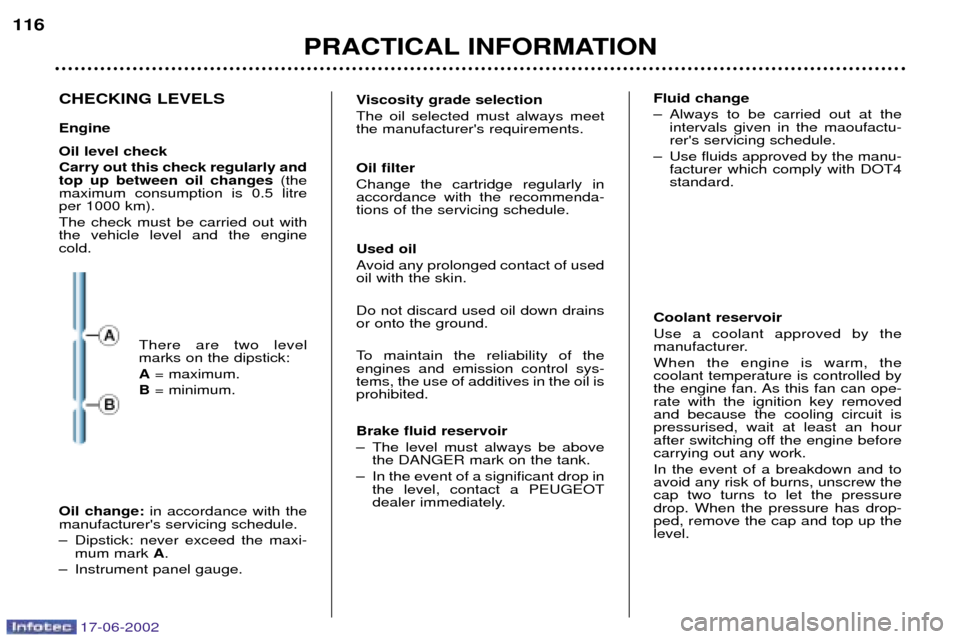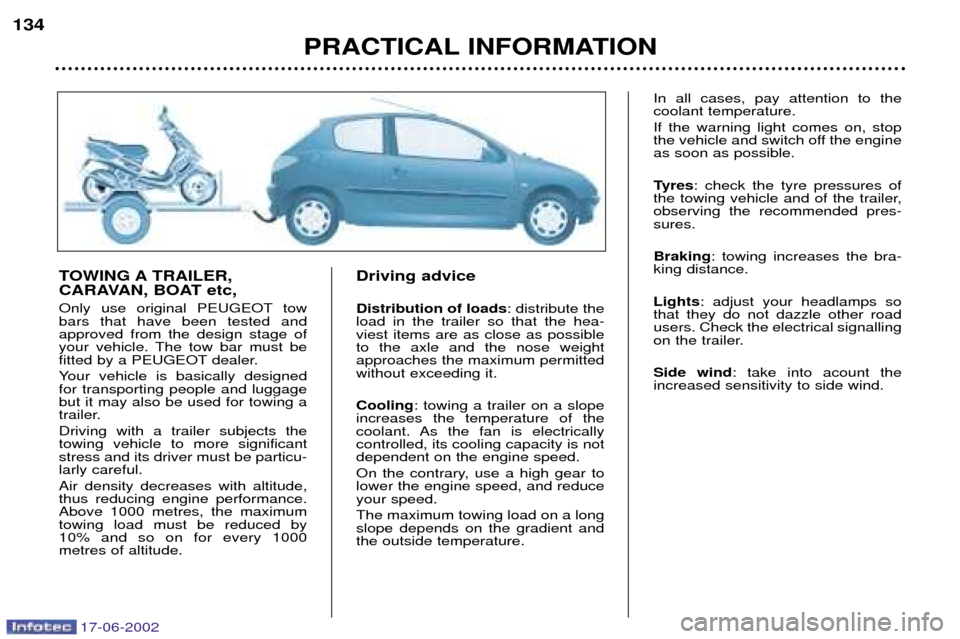cooling Peugeot 206 Dag 2002 Owner's Manual
[x] Cancel search | Manufacturer: PEUGEOT, Model Year: 2002, Model line: 206 Dag, Model: Peugeot 206 Dag 2002Pages: 155, PDF Size: 2.09 MB
Page 29 of 155

INSTRUMENTS AND CONTROLS
30
Handbrake, low brake fluid and ElectronicBrake Force Distributionsystem fault warning
light
Linked to the central (STOP) warning light. This indicates one of the following:
Ð that the handbrake is applied or not fully released,
Ð an excessive drop in brake fluid level (if the warning light remains on even when the handbrake isreleased).
Ð a fault in the Electronic Brake Force Distribution system, if lit at
the same time as the ABS warninglight.
You must stop.
Consult a PEUGEOT dealer.
INSTRUMENTS AND CONTROLS
A permanently lit warning light or one flashing, with the engine run-ning, indicates an operating faultof the unit concerned. The illumi-nation of certain warning lightsmay be accompanied by anaudible signal and a message on
the multi-function display. Do notignore this warning: consult aPEUGEOT dealer as soon as pos-sible.
If the central STOP warning light comes on when you are driving,
stop your vehicle immediately,where it is safe to do so.
Anti-lock Braking System (ABS) warninglight
If this warning light is permanentlyon, it indicates a malfunction of theABS.
However, the vehicle retains conventional servo-assisted bra-king.
Consult a PEUGEOT dealer.
Coolant temperature and low coolant level warninglight
Linked to the central (STOP) warninglight.You must stop.
Wait for the engine to cool before top-ping up the level. The cooling circuit is pressurised.In the event of breakdown and to prevent any risk of burns , unscrew
the cap by two turns to allow thepressure to drop. When the pressure has dropped, remove the cap and top up the level.
Consult a PEUGEOT dealer.
Central (STOP) warning light Linked to the "engine
oil pressure", "coolant temperature and low coolant level", "handbrake","low brake fluid level" and "electronicbrake force distribution system fault"warning lights.You must stop if the light flasheswith the engine running.
Consult a PEUGEOT dealer.
Engine oil pressure and temperaturewarning light
Linked to the central (STOP) warninglight.
You must stop.
This warning light indicates one ofthe following:
Ð insufficient oil pressure,
Ð a lack of oil in the lubrication cir- cuit. Top up the level.
Ð an oil temperature which is too high. The warning light is acompa-
nied by an audible signal. To lowerthe oil temperature, reduce yourspeed.
Consult a PEUGEOT dealer.
17-06-2002
Page 70 of 155

17-06-2002
YOUR 206 IN DETAIL69
3. Air distribution adjustment
Windscreen and side win- dows (de-icing/demisting).
To quickly de-ice or demist the wind-screen and side windows:
Ð turn the temperature and air flow controls to maximum,
Ð close the centre vents,
Ð position the air intake control to the left; the "Outside Air" position,
Ð start the air conditioning.
Windscreen, side windows and footwells. Footwells.
These settings are recommended for cold climates.
Centre and side vents.
This setting is recommended for hotclimates. 5. Air intake control
Intake of exterior air.
This is the normal operating posi-tion.
Recirculation of interior air.
This position prevents exteriorodours and smoke entering the pas-senger compartment. Used simultaneously with the air conditioning, recirculation enablesboth heating and cooling performan-ce to be improved. Used without the air conditioning, recirculation may result in misting ofthe windows. As soon as possible, position the control in the exterior air intake posi-tion. Important precaution Operate the air conditioning system for 5 to 10 minutes, once or twice amonth, to keep it in perfect working
order. If the system does not produce cold
air, do not use it and contact a
PEUGEOT dealer. Note:
to optimise the operation of
the air conditioning, leave the vents open.4. Air flow adjustment
Turn the control from posi- tion 1to position 4to obtain
an air flow sufficient toensure your comfort.6. Demisting the rear screen
With the engine running, press once to demist therear screen and the mir-rors.
It switches off automatically afterapproximately twelve minutes. Press again to switch it back on for twelve minutes. It is possible to stop demisting by pressing the button again before theend of the twelve minutes.
Page 121 of 155

17-06-2002
PRACTICAL INFORMATION
116
CHECKING LEVELS Engine Oil level check Carry out this check regularly and top up between oil changes (the
maximum consumption is 0.5 litreper 1000 km). The check must be carried out with the vehicle level and the enginecold.
There are two levelmarks on the dipstick: A= maximum.
B = minimum. Viscosity grade selectionThe oil selected must always meet the manufacturer's requirements. Oil filter Change the cartridge regularly in accordance with the recommenda-tions of the servicing schedule. Used oil
Avoid any prolonged contact of used oil with the skin. Do not discard used oil down drains or onto the ground.
To maintain the reliability of the engines and emission control sys-tems, the use of additives in the oil isprohibited. Brake fluid reservoir
Ð The level must always be above
the DANGER mark on the tank.
Ð In the event of a significant drop in the level, contact a PEUGEOT
dealer immediately. Fluid change
Ð Always to be carried out at the
intervals given in the maoufactu- rer's servicing schedule.
Ð Use fluids approved by the manu- facturer which comply with DOT4standard.
Coolant reservoir Use a coolant approved by the
manufacturer. When the engine is warm, the coolant temperature is controlled by
the engine fan. As this fan can ope-rate with the ignition key removedand because the cooling circuit ispressurised, wait at least an hour
after switching off the engine beforecarrying out any work. In the event of a breakdown and to avoid any risk of burns, unscrew thecap two turns to let the pressuredrop. When the pressure has drop-ped, remove the cap and top up thelevel.
Oil change: in accordance with the
manufacturer's servicing schedule.
Ð Dipstick: never exceed the maxi- mum mark A.
Ð Instrument panel gauge.
Page 144 of 155

17-06-2002
PRACTICAL INFORMATION
134
TOWING A TRAILER,
CARAVAN, BOAT etc,
Only use original PEUGEOT tow bars that have been tested andapproved from the design stage of
your vehicle. The tow bar must be
fitted by a PEUGEOT dealer.
Your vehicle is basically designed for transporting people and luggagebut it may also be used for towing a
trailer. Driving with a trailer subjects the towing vehicle to more significantstress and its driver must be particu-larly careful. Air density decreases with altitude, thus reducing engine performance.Above 1000 metres, the maximumtowing load must be reduced by10% and so on for every 1000metres of altitude. Driving advice Distribution of loads
: distribute the
load in the trailer so that the hea- viest items are as close as possibleto the axle and the nose weightapproaches the maximum permittedwithout exceeding it. Cooling : towing a trailer on a slope
increases the temperature of the
coolant. As the fan is electricallycontrolled, its cooling capacity is notdependent on the engine speed.
On the contrary, use a high gear to lower the engine speed, and reduceyour speed. The maximum towing load on a long slope depends on the gradient andthe outside temperature. In all cases, pay attention to thecoolant temperature. If the warning light comes on, stop
the vehicle and switch off the engineas soon as possible.
Tyres
: check the tyre pressures of
the towing vehicle and of the trailer, observing the recommended pres-sures. Braking : towing increases the bra-
king distance.Lights : adjust your headlamps so
that they do not dazzle other road users. Check the electrical signalling
on the trailer. Side wind : take into acount the
increased sensitivity to side wind.